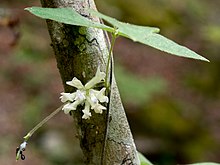
Summary
Amphicarpaea bracteata (hog-peanut or ground bean) is an annual to perennial vine in the legume family, native to woodland, thickets, and moist slopes in eastern North America.[2]
| Hog-peanut | |
|---|---|

| |
| Inflorescence | |
| Scientific classification | |
| Kingdom: | Plantae |
| Clade: | Tracheophytes |
| Clade: | Angiosperms |
| Clade: | Eudicots |
| Clade: | Rosids |
| Order: | Fabales |
| Family: | Fabaceae |
| Subfamily: | Faboideae |
| Genus: | Amphicarpaea |
| Species: | A. bracteata
|
| Binomial name | |
| Amphicarpaea bracteata (L.) Fernald
| |
| Synonyms[1] | |
|
l | |
Description edit
Leaves have three leaflets and are held alternately on twining stems.
Flowers are pink to white and bloom from late summer to autumn. The flowers are either open for cross-pollination or closed and self-pollinating. The closed flowers may be above or below ground.[3]
Seeds from open flowers are held in a flat pod, pointed at both ends, that dries when mature and twists to release the seeds. Seeds from closed flowers are held in round pods with a single seed each. The roots and the cooked seeds from under the ground are edible.[4][5] The seeds which become subterranean from flowers on stolons give it the name hog peanut.[6]
Location edit
This plant can be found in eastern North America, as well as further west into the Midwestern region, including Indiana,[6] Illinois,[6] and Wisconsin.[7]
References edit
- ^ "Amphicarpaea bracteata (L.) Fernald". International Legume Database & Information Service – via The Plant List. Note that this website has been superseded by World Flora Online
- ^ USDA, NRCS (n.d.). "Amphicarpaea bracteata". The PLANTS Database (plants.usda.gov). Greensboro, North Carolina: National Plant Data Team.
- ^ Trapp, E. Joseph; Hendrix, Stephen D. (March 1988), "Consequences of a mixed reproductive system in the hog peanut, Amphicarpaea bracteata, (Fabaceae)", Oecologia, 75 (2): 285–290, Bibcode:1988Oecol..75..285J, doi:10.1007/BF00378611, ISSN 1432-1939, PMID 28310848, S2CID 7629519
- ^ "Amphicarpaea bracteata". Plants for a Future.
- ^ Niering, William A.; Olmstead, Nancy C. (1985) [1979]. The Audubon Society Field Guide to North American Wildflowers, Eastern Region. Knopf. p. 520. ISBN 0-394-50432-1.
- ^ a b c Hilty, John (2020). "Hog Peanut (Amphicarpaea bracteata)". Illinois Wildflowers. "Archived copy". Archived from the original on 2019-08-26. Retrieved 2022-11-16.
{{cite web}}: CS1 maint: archived copy as title (link) CS1 maint: bot: original URL status unknown (link) - ^ Flora of Wisconsin, Wisconsin State Herbarium, University of Wisconsin–Madison
External links edit
- "Amphicarpaea bracteata". Plants for a Future.
- Native Plant Database profile, Lady Bird Johnson Wildflower Center, University of Texas at Austin
- Connecticut Plants, Connecticut Botanical Society
- Amphicarpaea bracteata in the CalPhotos photo database, University of California, Berkeley
- Missouri Plants Archived 2018-10-04 at the Wayback Machine


